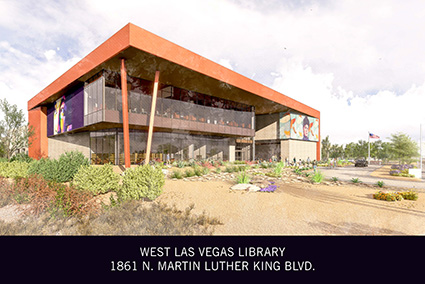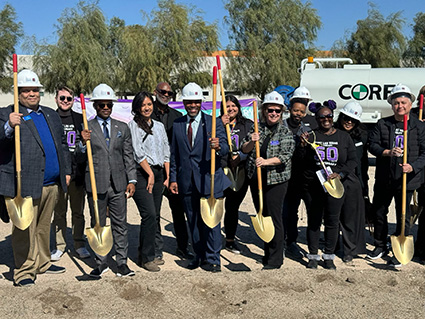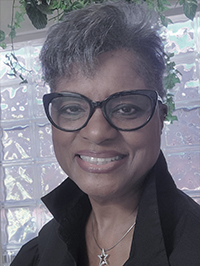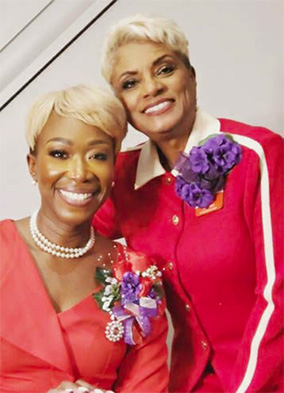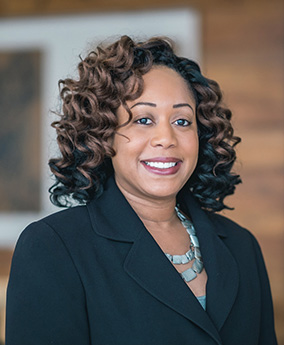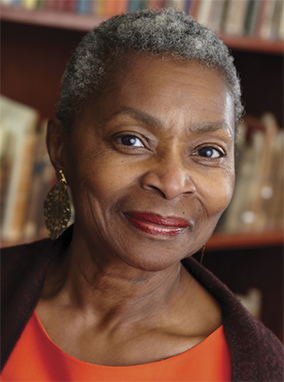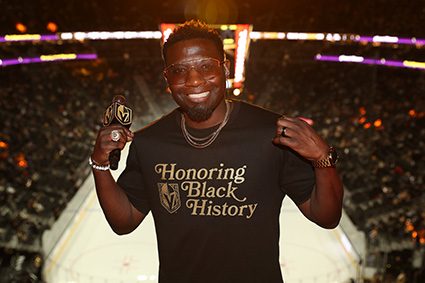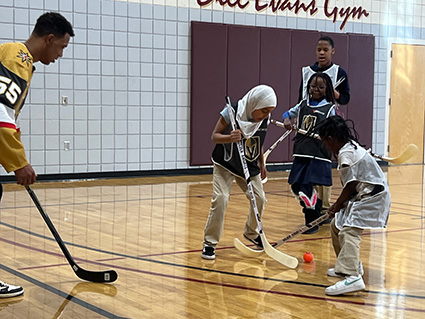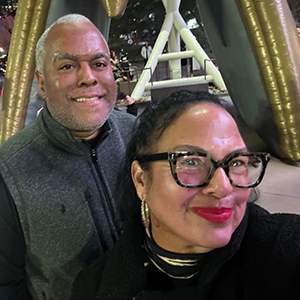Library District Breaks Ground on New 40,000 square-foot West Las Vegas Library
Date posted: March 25, 2024
State-of-the-art library doubles the size of the existing branch, and will serve as a new hub for literacy, learning, and community.
The West Las Vegas Library has served as a community anchor to the Historic Westside for 50 years. The Las Vegas-Clark County Library District announced that the West Las Vegas Library’s role in the community is expanding — with a new 41,178 square-foot, state-of-the-art branch.
A groundbreaking celebration was held February 27 at 1861 N. Martin Luther King Jr. Blvd, the location of the new library. It is slated to open in Fall 2025.
HEALTHIER YOU: Living with endometriosis
Date posted:
BY DR. MARGUERITE BRATHWAITE OB-GYN
March is Endometriosis Awareness Month.
Endometriosis is when tissue like the lining of the uterus grows outside of the uterus. It may affect more than 11% of American women between 15 and 44. It is especially common among women in their 30s and 40s, and may make it harder to get pregnant.
Several different treatment options can help manage the symptoms and improve your chances of getting pregnant. Symptoms of endometriosis can include:
● Pain, which is the most common symptom. Women with endometriosis may have various kinds of pain, including:
● Very painful menstrual cramps
● Chronic (long-term) pain in the lower back and pelvis.
● Pain during or after sex
● Intestinal pain
● Painful bowel movements or pain when urinating during menstrual periods.
● Bleeding or spotting.
● Infertility
● Stomach (digestive) problems
There is no cure for endometriosis, but treatments are available for the symptoms and problems it causes. Talk to your doctor about your treatment options or call Innovative Women’s Care at (702) 413-7740.
YOU! HAVE THE POWER | The love story of Medgar and Myrlie Evers
Date posted:
BY DR. ELLEN BROWN
EVERYTHING! That is what love has to do with it.
MSNBC personality Joy-Ann Reid came to Las Vegas on Feb. 17 for a discussion of her bestseller “Medgar and Myrlie” — a powerful, true love story set against the backdrop of s tumultuous, dangerous time for Black America.
Reid was the keynote speaker for the 111th Year Founder’s Day of Delta Sigma Theta Sorority, Inc., hosted at the Sahara Hotel by the Las Vegas Alumnae Chapter (Dr. Rebecca Rogers, President). An honorary Delta, Reid shared gifts of knowledge and power about the work and commitment of Medgar and Myrlie, who helped create a stronger foundation of love at a time when hate threatened to consume America. “The ReidOut” host spoke about focusing a lens of truth on the civil rights legends, whose stories did not begin and end when Medgar was assassinated in 1963 at the age of 37. Even though truths behind this hateful act have emerged over the past 61 years, it can never be enough or forgotten.
In her book, Reid documents how common it was for whites to kill Blacks and face a system of justice that looked the other way. Unequal economics, assassinations, “separate-but-equal” education, lack of voting rights, unequal economics and more led to Mississippi being labeled as the most terrorized state in the country. An eye-opener in Reid’s book is her commentary on how Blacks always had to “move out” to find justice and safety.
At the center of it all, though, is a love story. Myrlie wanted to be a housewife and a mother. Her love for her husband, his civil rights work, and safety for their children compelled her to do what women do: get involved to protect her home and family. When Medgar was assassinated, Myrlie realized even more the significance of supporting the movement. A widow with three children at the age of 30 Myrlie could not ignore the wrongs and would not move to another place.
Not totally sure their agenda lined up with hers — and angry with a system that led to her husband being assassinated and leaving behind a wife and three children — she joined the movement of the NAACP. Myrlie committed herself to the civil rights movement providing for her the common platform needed to affect change to this day. Myrlie continued her love story with Medgar as she learned how to become a civil rights widow.
Reid masterfully shares how her own love story of justice, freedom and hope works for her. It is centered on a belief that every human being is entitled to first-class citizenship, freedom, and hope. Rev Dr. Martin Luther King, Jr. in his 1963 “Letter from a Birmingham Jail,” wrote, “Freedom is never given voluntarily by the oppressor. You must demand it, for it will not be given freely.”
Dr. Ellen Brown enjoys sharing YOUR stories and writing on topics that encourage, enlighten, and invite discussion that leads to Action. Ellen welcomes your ideas and stories on how you use your Power! Ebrown.nci@gmail.com
Fostering Hope: Court Appointed Special Advocates Volunteers Making A Difference
Date posted:
By Dr. Lisa Morris-Hibbler
In a world where hardships are commonplace, one of the most tragic facts is the existence of kids who wind up in the foster care system. These young people are already dealing with difficulties that most adults would find incomprehensible, and now they have to endure the turbulent trip through the unknowns of foster care. The Court Appointed Special Advocates (CASA) volunteers are a beacon of love and hope in these turbulent waters, giving children the precious gift of quality time and, most importantly, an opportunity for a better future. CASA volunteers have professional careers such as teachers, nurses, lawyers, realtors, business and government leaders, and retirees.
In Clark County, there are more than 3,000 children placed in foster care due to circumstances beyond their control. These children struggle with the uncertainties of their future while carrying the emotional scars of their past — be it abuse, neglect, or other unfavorable circumstances. For them, the presence of a CASA volunteer, like me, is frequently the first sign of stability in an unstable environment. The Eighth Judicial Court- CASA Program has 400 volunteers that represent nearly 1,000 children annually. The goal, of course, is to have enough CASA volunteers to ensure that every child can be assigned an advocate.
CASA volunteers have a real impact on the lives of the children they serve. Studies have shown that children with CASA volunteers are more likely to be reunified with their families and placed in permanent homes sooner.
A Glimpse into the Lives of Foster Children
Before I share my story, it is important to understand the difficulties and complexities that foster children face. These kids are frequently exposed to terrible events and are suddenly thrown into an unknown and frightening world. They could feel abandoned and lost since they are cut off from their homes, family, and everything they once knew. Their emotional and psychological well-being may be seriously impacted by the emotional turmoil and instability they experience.
Many foster children are shuffled from one placement to another, which disrupts any sense of consistency in their lives. It is not uncommon for these children to change schools frequently, making it difficult for them to form meaningful relationships with peers or teachers. This lack of stability can have a lasting impact on their educational and emotional development.
Moreover, the foster care system itself can be a daunting labyrinth of bureaucracy and legal proceedings. For a child, navigating this system can be overwhelming and confusing. This is where the CASA volunteers come in, offering a steady hand, consistent presence, and a caring heart to guide these children through the challenges they face.
Case Assignments: My Experience as a CASA Volunteer
Upon finishing my CASA volunteer training, I was immediately assigned a case. My nerves started setting in as I thought about the first meeting. Would the children accept me, would they want to meet yet another stranger? Our training prepared us for this day — but now, I would be put to the test. When I accepted my first case as a CASA volunteer, I was assigned an African-American sibling group of three. They had been placed with a family member. I was so glad the children were able to stay together and keep their bond intact. So often, siblings are separated when a suitable placement cannot be readily identified. As their CASA advocate, I was determined to provide the consistency and support they so desperately needed.
Our first meeting began with snacks and a conversation. I learned about their favorite hobbies, their dreams, and fears. We spent time doing homework, going to fun activities, playing sports, video games, and eating at various restaurants. Through these seemingly ordinary moments, I began to see beautiful personalities flourish and bright smiles emerge.
Over time, I saw the positive impact that my consistent presence had on this family’s life. They began to open up, sharing their thoughts and feelings more freely. Their confidence grew, and they started to believe in their own potential. I attended school meetings and academic conferences to ensure the children were on track and accessing the resources they needed. By the time the case was closed and their relative became their legal guardian, the children were in a stable and loving home, involved in extracurricular activities, and academically doing well.
Two years later, I was assigned to my second case advocating for an African American sibling group of four. The children are not Nevada residents and I am working with Family Services to get them reunited with family in another state. Weekly, I make visits to Child Haven to check on the children. Child Haven is a specialized campus that provides congregate care to children who are placed in protective custody or awaiting placement and keep siblings together.
Serving as a CASA volunteer is undoubtedly rewarding, it is not without its challenges. There were moments when I felt frustrated by the complexities of the foster care system, the education system hurdles, and the heart-wrenching stories of the children I encountered. However, these challenges only fueled my determination to advocate for the best interests of my CASA kids.
My personal experience as a CASA volunteer has been a profound and life-changing one. I have learned that with dedication, empathy, and unwavering support, we can be the catalyst for positive change in the lives of these vulnerable children. The smiles, the moments of laughter, and the remarkable resilience I’ve witnessed in the children I have served have been my greatest rewards. Every day, I am reminded of the importance of having a consistent, caring adult in the life of a foster child. I have seen firsthand how being that one significant person can make all the difference, offering hope, support, and the promise of a better future.
HISTORIC BLACK VEGAS: Black Wall Street
Date posted:
BY CLAYTEE D. WHITE
On a Saturday evening in February, I attended a presentation by archaeologist Alicia Odewale, PhD. She is investigating the 1921 race riot in the Black town of Greenwood, just across the tracks from Tulsa, Oklahoma.
The scream of a white female elevator operator, when her Black male passenger lost his balance, led to his arrest. Because the elevator didn’t stop evenly at a landing, he stumbled and grabbed her arm as he exited — and tragically, her story (that nothing happened, and that he should be released) did not quell the harsh atmospheric tensions. Both the Black and white communities armed themselves. The firepower of the White community, which included dropping incendiary devices from aircraft, overwhelmed the Black community’s defensive measures. Thus, the white barrage of the Greenwood community destroyed businesses, homes, and carted off Blacks to internment camps. There is a film, a “60 Minutes” episode, and a wealth of writings about the attack on Black Wall Street.
The Smith Center presentation, produced by National Geographic, was stellar. It allowed audience interaction, but Dr. Odewale was spirited away too soon. We could have conversed with her for the rest of the night.
Beginning in 1919, this period is sometimes called the Red Summer because there were these kinds of attacks by Whites on Black communities in over two dozen cities across the United States. The National WWI Museum and Memorial traces the cause to Black soldiers returning from the war in Europe with a bit of a swagger and may have been unwilling to submit to the typical Jim Crow treatment of that era. The second reason was related to the Black migration from the South that created competition for jobs in northern cities and exhausted the supply of workers in the South. Riots occurred in Washington, DC; Chicago, Illinois; Omaha, Nebraska; Norfolk, Virginia; Wilmington, Delaware; Houston, Texas; and the deadliest of all, in Elaine, Arkansas.
This violence did not spread to Las Vegas. However, the revived Ku Klux Klan marched down Fremont Street in full regalia — but not until 1925.
Some cities encountered this severe racial tension when Blacks were hired as scabs by large companies thus causing friction between Black and white workers.
Clarence Ray tells the story of being hired for a job on the railroad in 1922 in Las Vegas but sneaked out of town to return to California when he discovered that he had been hired as a scab to break a strike. In this period, Las Vegas’ Black community was spurred to organize.
In the 1920s, Black leaders formed a Colored Democratic Club, a Colored Republican Club, the Colored Citizens Labor Protective Association, and a branch of the NAACP. I believe these organizational efforts were for reasons beyond jobs and politics. Maybe these groups proved to be protection from chaos and allowed for Black survival.
Golden Knights Celebrate Black History Month
Date posted:
The Vegas Golden Knights held a series of events in February to celebrate Black History Month, highlighted by their Black History Knight game on Tuesday, February 20. Although the VGK dropped that contest to Nashville, 5-3, the theme of “Honoring Black History” was celebrated throughout the night.
Prominent Black members of the VGK organization took their usual spots in the spotlight — from forward Keegan Kolesar on the ice to assistant coach Joel Ward behind the bench. Carnell “Golden Pipes” Johnson belted out the national anthem to start the game and in-game host Bojo Ackah and DJ Joe Green entertained the sellout crowd.
In addition, special guests at the game included leadership from the Las Vegas Urban Chamber of Commerce and Wendell P. Williams, the founder of the city’s Dr. Martin Luther King Jr. Parade and a former state assemblyman. The Knights Salute program — which allows season-ticket members to donate tickets to deserving members of the community — donated more than 40 tickets to the game to staff and Board members from the brand new Donna Street Community Center, and DJ Kelly J performed during the second intermission Knight Club.
The day after the game, Donna Street Community Center celebrated its grand opening, with the Golden Knights organization in attendance and hosting ball hockey for kids. The VGK Foundation is a proud sponsor of the center’s podcast room.
Other ball hockey events in the community included Kolesar and Ward visiting the Doolittle Community Center for a clinic with dozens of kids on February 16.
“Anytime you can help the community it’s a big honor,” said Kolesar. “Especially with the heritage that Joel and I come from. We get the opportunity to come and help out and grow the game in communities like this. It means the world to us. I think it’s an honor to be able to do this.”
The Golden Knights also hosted several hours of ball hockey at the Springs Preserve Black History Month Festival.
“I think it’s our job at this level is to introduce the game and to get out in the communities because a lot of people would love the opportunity to be part of it,” said Ward. “We can continue as a group to introduce the game. Whether it’s playing a little ball hockey here or handing hockey cards, it’s about getting a little bit of interest. Those sparks can pay a lot of dividends to different neighborhoods and different people.”
Right This Way
Date posted:
One of the biggest names in pop shows how to Usher in a new era of Las Vegas entertainment
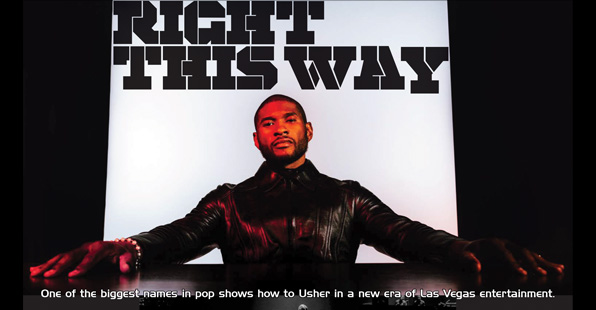
Photos by Bellamy Brewster
Las Vegas was lit up bright on Super Bowl weekend — as luminaries from all over the world took over the city for the year’s biggest spectacle of sports, entertainment, and celebrity.
Yes, there was a game — which ended up being an all-time classic — to be played at Allegiant Stadium, and the celebration of Black History Month added to the excitement. But few things rivaled the buzz created by the halftime entertainment, as superstar entertainer Usher took the stage with special guests as Lil’ Jon, Ludacris, and Alicia Keys.
The show was filled with familiar hits from throughout Usher’s career, songs from his latest album, “Coming Home,” and roller-skating moments from his Vegas residency show. The eight-time Grammy winner, whose wildly successful 100-show Las Vegas residency has drawn international headlines, said his goal was to bring a taste of his hometown to Nevada. “I turned the Vegas V upside down,” he said, “bringing the ATL to the Silver State.”
Usher’s love for Atlanta, however, translated well into a pride for Black Las Vegas that he has developed during his stay: he took cameras on a tour of the Historic Westside, including stops at historic Harrison House, Walker African American Museum, and much more. And away from the cameras, Usher and the mother of two of his children, Jennifer Goicoechea, married at a Las Vegas drive-thru, accompanied by close friends and family.
With his unforgettable performance, Usher joined a list of celebrated entertainers who have played the Super Bowl halftime show — including Prince, Beyonce, Madonna, Michael Jackson, and Dr. Dre and Snoop Dogg. To mark that history, the City of Las Vegas presented Usher with a proclamation for his contributions to the Las Vegas community where he has visited and spoke to local Clark County School District students to encourage their educational journey.
Commenting right before his performance began, Usher summed it all up: “I was very mindful of my past, celebrating my present, which is here in Las Vegas, and thinking about where we’re heading in the future.”
Who In The Heck Raised These People?
Date posted: March 17, 2024
BY LOUIE OVERSTREET
Before you ask it, let me answer the question you have in mind: Who are “those people,” right? Well, I am going to reveal their identity later.
In a simpler time, I remember being raised with a sense of family, respect for your elders, kindness to others, help when you are able to do so, and (with what had to be the universal admonition of the time), making sure to wear clean underwear in case you get in and accident and have to go to the hospital.
Further, I used to be good at playing “The Dozens” on the playgrounds of Cleveland schools, back in the late 1940s and the early 1950s. Given what is taking place in America nowadays, it may be time for me to again talk about somebody’s momma — and for that matter, their poppa, too.
Time to reveal who “those people” are. They are ungodly evangelicals, greedy and spineless politicians, as well as our bigoted relatives and friends who come in all colors (and parenthetically, I need to identify them as the culprits who are letting our nation go to hell in a handbasket).
While purporting to be a Christian nation governed by laws providing for the separation of church and state, it would be difficult to find the proof in today’s puddings. Evangelicals and “repug” politicians have formed an unholy alliance that makes you want to barf. Those people need to be doctors, that way these non-licensed physicians could heal themselves.
We all know the best place to observe bigotry in action is in the attitudes expressed and actions taken by bigoted people who keep our nation in social turmoil. Among those people, as noted, are our relatives and friends. No matter how hard you try to duck them, they are always in your face using vile invectives, not to mention voting against their own interests, due to their hate-filled hearts.
Sadly, the foregoing are those people who are turning the dream of America into our nation’s nightmare!
LETTER FROM THE PUBLISHERS: Ushering in a new era of Vegas entertainment
Date posted:
This issue of Las Vegas Black Image is bursting with stories and photos showcasing the best of Black History Month 2024. And the celebration was magnified this year — as Las Vegas played host to the Super Bowl and its spectacle of star-studded events with a crush of media from around the world.
That excitement is encapsulated in the man who appears on our cover: Usher has put his forever stamp on the history of Las Vegas entertainment — with his 100-show residency here in Sin City, and for bringing down the house at the halftime of the big game at Allegiant Stadium.
Also inside:
● Exclusive coverage of the 24th Annual Las Vegas Taste & Sounds of Soul/Black Image Honors event, in collaboration with the Las Vegas-Clark County Library District. Nine outstanding individuals, known as “The Real Ones,” were honored for their contributions to community and diversity.
● Highlights from Super Bowl Week, including honors for actress Holly Robinson-Peete and other phenomenal women.
● In Community Speaks, Las Vegas residents weigh in on the most impactful events during Black History Month.
Our beloved readers, treasured advertisers and contributors, and the community we all cherish are what propel Las Vegas Black Image forward. You are the blessing.
Rise,
Charles Tureaud & Kimberly Bailey Tureaud
Publishers
(702) 615-8216
cdalasvegas@gmail.com
LasVegasBlackImage.com
PEACE: The Pull Up
Date posted:
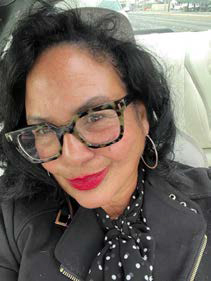
BY KIMBERLY BAILEY-TUREAUD
Yes, that day, I was feeling really bad, Ms. Celie. But you helped me.” This line in “The Color Purple” speaks volumes about sisterhood and the woman-to-woman connection that heals.
People often mask their emotions, hiding the pain in their spirit. We have grown so accustomed to disguising hurt — it happens unconsciously, in line with the admonition, “Don’t tell nobody your business,” which rings loud in our cultural conditioning.
But, in your solitude, there might be an unexpected knock at your door from a few sister-loves you have hidden from, who can find the space to help heal the wounds of the heart. Discovery is bliss.
Just like the sun demands your attention, your sister-loves (who really see you) will pull up! The rhythmic vibration of your silence roars like a drumbeat in their souls — drawing them to come check on you. Love is so powerful. And the love of a true sister-friend is one that can never disappear. It’s there when you least expect it.
The Pull Up is necessary, and our ancestors demand it. Planted in our DNA is the voice of strength, wisdom, empathy and love. Listen to that. It will maintain sister drivers in all lanes, so that none of us are left behind.
Practice the Pull Up of your own, by not allowing the needed voice to go silent. Send that card, call that number, or text that loving message. If there is no response, pull up with love and a hug. Prayer in action will save us all!
